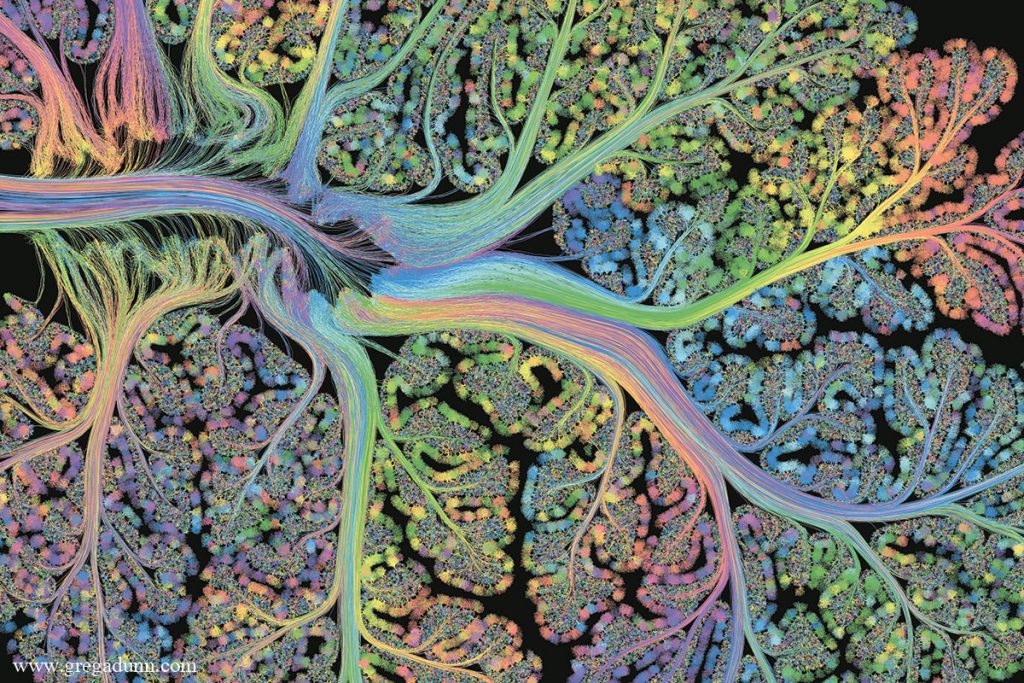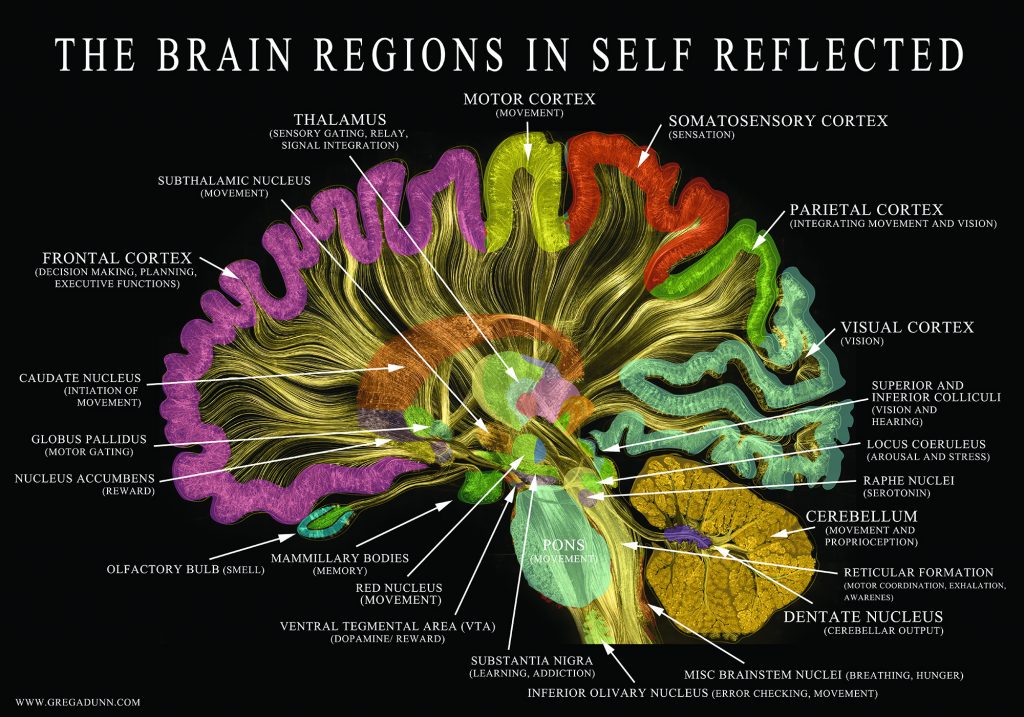
Self Reflected in violets. The entire Self Reflected microetching under violet and white light (photo by Greg Dunn and Will Drinker)
This is the most advanced artistic visualisation of the brain in the world.
Dr Greg Dunn is an artist and neuroscientist and together with Dr Brian Edwards (artist and physicist) he created Self Reflected.
“Self Reflected was created to remind us that the most marvellous machine in the known universe is at the core of our being.”
The work bridges the connection between the macroscopic brain and the behaviour of neurons through a technique called reflective microetching.
These images are NOT brain scans. They are meticulously created through a combination of hand drawing, deep neuroscience research, algorithmic, simulation, digital design, photolithography, gilding, and strategic lighting.
Brain activity is animated by light reflecting off a golden surface and offers an unprecedented look at the beauty and awe of our inner selves.

Visual cortex – the visual cortex, the region located at the back of the brain that processes visual information. Self Reflected (detail), 22K gilded microetching, 96″ X 130″, 2014-2016, Greg Dunn and Brian Edwards.

Secondary visual cortex – the secondary visual cortex, where the visual system processes how objects are oriented in three-dimensional space. Self Reflected (detail), 22K gilded microetching, 96″ X 130″, 2014-2016, Greg Dunn and Brian Edwards.

Thalamus and Basal Ganglia – the thalamus and basal ganglia, sorting senses, initiating movement, and making decisions.Self Reflected (detail), 22K gilded microetching, 96″ X 130″, 2014-2016, Greg Dunn and Brian Edwards.

Basal Ganglia – made up of various structures including the striatum; both dorsal striatum (caudate nucleus and putamen) and ventral striatum (nucleus accumbens and olfactory tubercle), globus pallidus, ventral pallidum, substantia nigra, and subthalamic nucleus. Self Reflected (detail), 22K gilded microetching, 96″ X 130″, 2014-2016, Greg Dunn and Brian Edwards.

Pons and brainstem close up – the pons is a region involved in movement and implicated in consciousness (photo by Greg Dunn and Will Drinker).Self Reflected (detail), 22K gilded microetching, 96″ X 130″, 2014-2016, Greg Dunn and Brian Edwards.

Cerebellar folia – the laminar structure of the cerebellum, a region involved in movement and proprioception (calculating where your body is in space). Self Reflected (detail), 22K gilded microetching, 96″ X 130″, 2014-2016, Greg Dunn and Brian Edwards.

Reticular formation – is a set of interconnected nuclei that are located throughout the brainstem. The neurons of the reticular formation all play a crucial role in maintaining behavioural arousal and consciousness. Self Reflected (detail), 22K gilded microetching, 96″ X 130″, 2014-2016, Greg Dunn and Brian Edwards.


To give a sense of scale, here is Brian crouching over an array of cut plate (photo by Will Dunker).
This video shows how the piece is especially impressive when you can see the movement of light).
Learn and see more of Greg Dunne’s work at his website: : http://www.gregadunn.com/self-reflected/
Share the love
[Sassy_Social_Share]
11 Comments
Leave a Comment
About Dr Sarah
Neuroscientist, Author, Speaker, Director of The Neuroscience Academy suite of professional training programs.
Latest Posts
Free 10 day micro-training in neuroscience

Learn one neuroscience concept a day!
10 simple, bite-sized lessons in brain health, delivered daily to your inbox


Beautiful!!
Fascinatingly Beautiful!!!
Thank you so very much!!!
This is the most amazing artwork I have ever seen ❤️
Wow! Unique, inspiring, and intriguing!!
Thank you both for your gifted work.
This is amazing & awe inspiring – thank you so much for sharing.
Awesome!
It is very Informative Post.
Thanks for sharing this post with us.
Absolutely stunning! I am wondering if using the word “machine” to describe the brain is correct? Machines are man-made complicated ‘things’. The brain is far more complex, systems within systems.
Awesome! The power of technology is really intriguing. It allows us to look at our brain in a different perspective. Thanks for sharing.
These images of this most remarkable part of us are not only stunningly beautiful — they are quite humbling…
Beautiful nice approach i am very inspired by Dr Greg Dunn thanks for it.